Welcome to our blog post on Yield strategies in DeFi!
Introduction to Staking in DeFi
Staking has become a popular strategy in the world of Decentralized Finance (DeFi). This involves locking a blockchain’s native tokens to help secure the network and validate transactions. In return, stakers earn rewards in the form of transaction fees and additional token emissions. The rewards earned from staking can vary depending on the level of network activity.
Exploring Recursive Lending
Another interesting yield generation strategy in DeFi is recursive lending. This involves borrowing assets against existing collateral, then staking or lending out those borrowed assets to earn additional rewards. This recursive process can potentially amplify the returns for investors, but also comes with increased risks.
How Staking and Recursive Lending Affect Investors
For individual investors, participating in staking and recursive lending can offer the opportunity to earn passive income on their crypto holdings. By locking up their tokens in staking contracts or engaging in recursive lending, investors can potentially earn higher returns compared to traditional savings accounts or investment vehicles.
Impact on the World
On a larger scale, the rise of yield strategies in DeFi has the potential to revolutionize the traditional financial system. By decentralizing finance and offering new ways for individuals to earn income on their crypto assets, DeFi could democratize access to financial services and empower individuals around the world.
Conclusion
In conclusion, yield strategies such as staking and recursive lending present exciting opportunities for investors in the world of DeFi. By participating in these strategies, investors can potentially earn higher returns on their crypto holdings and contribute to the growth of decentralized finance. As DeFi continues to evolve, it will be interesting to see how these yield strategies shape the future of finance.





